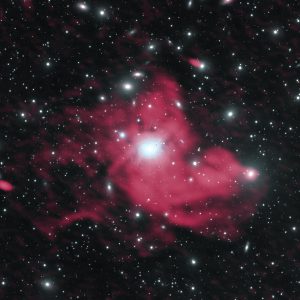CRAQ’s researchers used the VLA to get new insight into galaxy cluster’s spectacular “mini-halo”
 An international team of astronomers, led by Professor Julie Hlavacek-Larrondo and her PhD student Marie-Lou Gendron-Marsolais, both from the Center for Research in Astrophysics of Quebec (CRAQ) and Université de Montréal, used the National Science Foundation’s Karl G. Jansky Very Large Array (VLA) to discover new details that are helping them decipher the mystery of how giant radio-emitting structures are formed at the center of a cluster of galaxies.
An international team of astronomers, led by Professor Julie Hlavacek-Larrondo and her PhD student Marie-Lou Gendron-Marsolais, both from the Center for Research in Astrophysics of Quebec (CRAQ) and Université de Montréal, used the National Science Foundation’s Karl G. Jansky Very Large Array (VLA) to discover new details that are helping them decipher the mystery of how giant radio-emitting structures are formed at the center of a cluster of galaxies.
Perseus Cluster. Credits : Julie Hlavacek-Larrondo, Marie-Lou Gendron-Marsolais et Maxime Pivin-Lapointe.
The scientists studied a cluster of thousands of galaxies more than 250 million light-years from Earth, named the Perseus Cluster after the constellation in which it appears. Embedded within the center, the Perseus Cluster hosts a pool of superfast particles that emit radio waves, creating a radio structure known as a “mini-halo.” Mini-haloes have been found in about 30 galaxy clusters, but the halo in the Perseus Cluster is the largest known, about 1.3 million light-years in diameter, or 10 times the size of our Milky Way Galaxy.
The sizes of the mini-haloes have presented a puzzle to astronomers. As the particles travel away from the cluster’s center, they should slow down and stop emitting radio waves long before they reach the distances observed, according to theory.
“At large distances from the central galaxy, we don’t expect to be able to see these haloes,” said Marie-Lou Gendron-Marsolais. “However, we do see them and we want to know why,” she added.
The astronomers took advantage of the upgraded capabilities of the VLA to make new images of the Perseus Cluster that were both more sensitive to fainter radio emissions and provided higher resolution than previous radio observations.
“The new VLA images provided an unprecedented view of the mini-halo by revealing a multitude of new structures within it,” said Professor Julie Hlavacek-Larrondo. “These structures tell us that the origin of the radio emission is not as simple as we thought,” she said.
The new details indicate that the halo’s radio emission is caused by complex mechanisms that vary throughout the cluster. As theorized before, some radio emission is caused by particles being reaccelerated when small groups of galaxies collide with the cluster and give the particles a gravitational shove. In addition, however, the scientists now think that the radio emission is also caused by the powerful jets of particles generated by the supermassive black hole at the core of the central galaxy that give an extra “kick” of energy to the particles.
“This would help explain the rich variety of complex structures that we see,” Gendron-Marsolais said.
“The high-quality images that the upgraded VLA can produce will be key to helping us gain new insights into these mini-haloes in our quest to understand their origin,” Hlavacek-Larrondo said.
The VLA, built during the 1970s, was equipped with all-new electronics to bring it up to the technological state of the art by a decade-long project completed in 2012.
Gendron-Marsolais and Hlavacek-Larrondo, along with an international team of researchers, are reporting their findings in the latest edition of Monthly Notices of the Royal Astronomical Society.
The National Radio Astronomy Observatory is a facility of the National Science Foundation, operated under cooperative agreement by Associated Universities, Inc.
A copy of the scientific paper is available here.
Contact:
Professor Julie Hlavacek-Larrondo
Center for Research in Astrophysics of Quebec
Université de Montréal
juliehl@astro.umontreal.ca
Marie-Lou Gendron-Marsolais
Center for Research in Astrophysics of Quebec
Université de Montréal
marie-lou@astro.umontreal.ca
Source:
Robert Lamontagne
Public outreach
Center for Research in Astrophysics of Quebec
Université de Montréal
Phone : (514) 343-6111 x3195
lamont@astro.umontreal.ca
